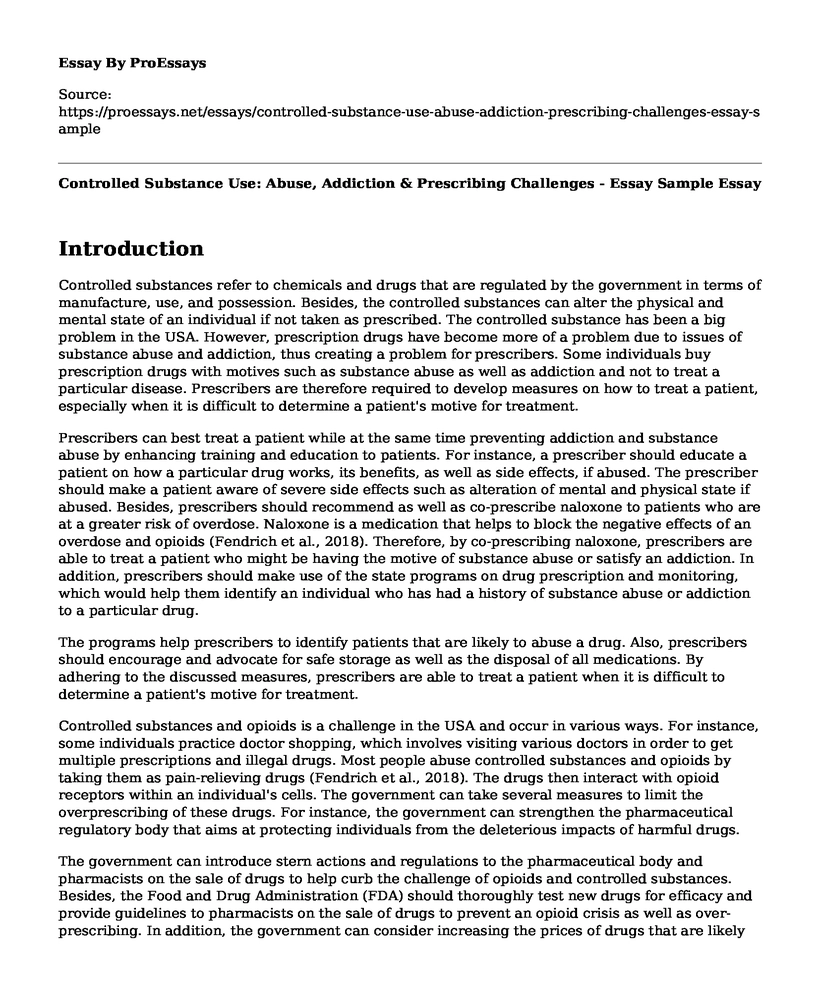Introduction
Controlled substances refer to chemicals and drugs that are regulated by the government in terms of manufacture, use, and possession. Besides, the controlled substances can alter the physical and mental state of an individual if not taken as prescribed. The controlled substance has been a big problem in the USA. However, prescription drugs have become more of a problem due to issues of substance abuse and addiction, thus creating a problem for prescribers. Some individuals buy prescription drugs with motives such as substance abuse as well as addiction and not to treat a particular disease. Prescribers are therefore required to develop measures on how to treat a patient, especially when it is difficult to determine a patient's motive for treatment.
Prescribers can best treat a patient while at the same time preventing addiction and substance abuse by enhancing training and education to patients. For instance, a prescriber should educate a patient on how a particular drug works, its benefits, as well as side effects, if abused. The prescriber should make a patient aware of severe side effects such as alteration of mental and physical state if abused. Besides, prescribers should recommend as well as co-prescribe naloxone to patients who are at a greater risk of overdose. Naloxone is a medication that helps to block the negative effects of an overdose and opioids (Fendrich et al., 2018). Therefore, by co-prescribing naloxone, prescribers are able to treat a patient who might be having the motive of substance abuse or satisfy an addiction. In addition, prescribers should make use of the state programs on drug prescription and monitoring, which would help them identify an individual who has had a history of substance abuse or addiction to a particular drug.
The programs help prescribers to identify patients that are likely to abuse a drug. Also, prescribers should encourage and advocate for safe storage as well as the disposal of all medications. By adhering to the discussed measures, prescribers are able to treat a patient when it is difficult to determine a patient's motive for treatment.
Controlled substances and opioids is a challenge in the USA and occur in various ways. For instance, some individuals practice doctor shopping, which involves visiting various doctors in order to get multiple prescriptions and illegal drugs. Most people abuse controlled substances and opioids by taking them as pain-relieving drugs (Fendrich et al., 2018). The drugs then interact with opioid receptors within an individual's cells. The government can take several measures to limit the overprescribing of these drugs. For instance, the government can strengthen the pharmaceutical regulatory body that aims at protecting individuals from the deleterious impacts of harmful drugs.
The government can introduce stern actions and regulations to the pharmaceutical body and pharmacists on the sale of drugs to help curb the challenge of opioids and controlled substances. Besides, the Food and Drug Administration (FDA) should thoroughly test new drugs for efficacy and provide guidelines to pharmacists on the sale of drugs to prevent an opioid crisis as well as over-prescribing. In addition, the government can consider increasing the prices of drugs that are likely to be abused and overprescribed to discourage people from buying them (Peckham, & Sclar, 2018). For patients who become problematic, stern actions should be taken on them, such as arresting them for substance abuse. Besides, problematic patients should be taken to rehabilitation centers where officers can help to rehabilitate them and thus help deal with the issue of over-prescription and opioids. Moreover, stern actions should be taken on doctors and other health care providers who willing to over-prescribe drugs to their patients.
Given a chance to work in a field where I prescribe controlled substances, I would develop measures to work with difficult patients. For instance, I would involve their close family members to help cushion them on the negative effects of over-prescription of drugs to the patient. Besides, I will be empathetic to the difficult patients to help in making them calm and control their anger as I advise them on the need not to take too many drugs or to use them inappropriately. In addition, I would be cautious while prescribing certain steroid hormones, drugs for insomnia, as well as stimulants that may seem attractive to patients by only recommending them as a second option when the primary drugs fail to be effective.
References
Fendrich, M., Bryan, J. K., & Hooyer, K. (2018). Prescription drug monitoring programs and pharmacist orientation toward dispensing controlled substances. Substance use & misuse, 53(8), 1324-1330. Retrieved from https://www.tandfonline.com/doi/abs/10.1080/10826084.2017.1408650
Peckham, A. M., & Sclar, D. A. (2018). Need for international classification of gabapentin as a controlled substance. BMJ. 363. Retrieved from https://www.bmj.com/content/363/bmj.k4978.short
Cite this page
Controlled Substance Use: Abuse, Addiction & Prescribing Challenges - Essay Sample. (2023, May 05). Retrieved from https://proessays.net/essays/controlled-substance-use-abuse-addiction-prescribing-challenges-essay-sample
If you are the original author of this essay and no longer wish to have it published on the ProEssays website, please click below to request its removal:
- Police Brutality Against the African Americans Essay
- Asian Immigration to the US: From 1880s to Now - Research Paper
- Drugs and Crime: An Unavoidable Connection - Research Paper
- Essay on Combatants' Pleasure-Seeking in Violence: Islamic Militancy & Combat Motivations
- Essay Example on Immigrants Seek Better Opportunities Abroad
- Racial Inequality in America: Pre-Independence to 21st Century - Essay Sample
- Paper Sample on Cultural Theory: Explaining Jewish vs Italian Immigrants in America 1910-1914







